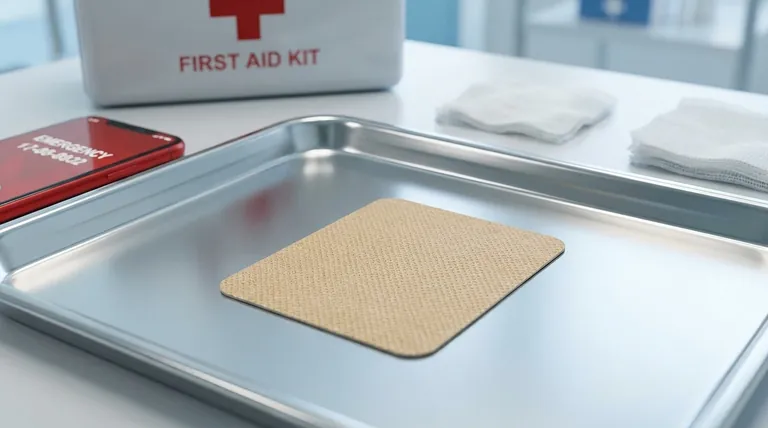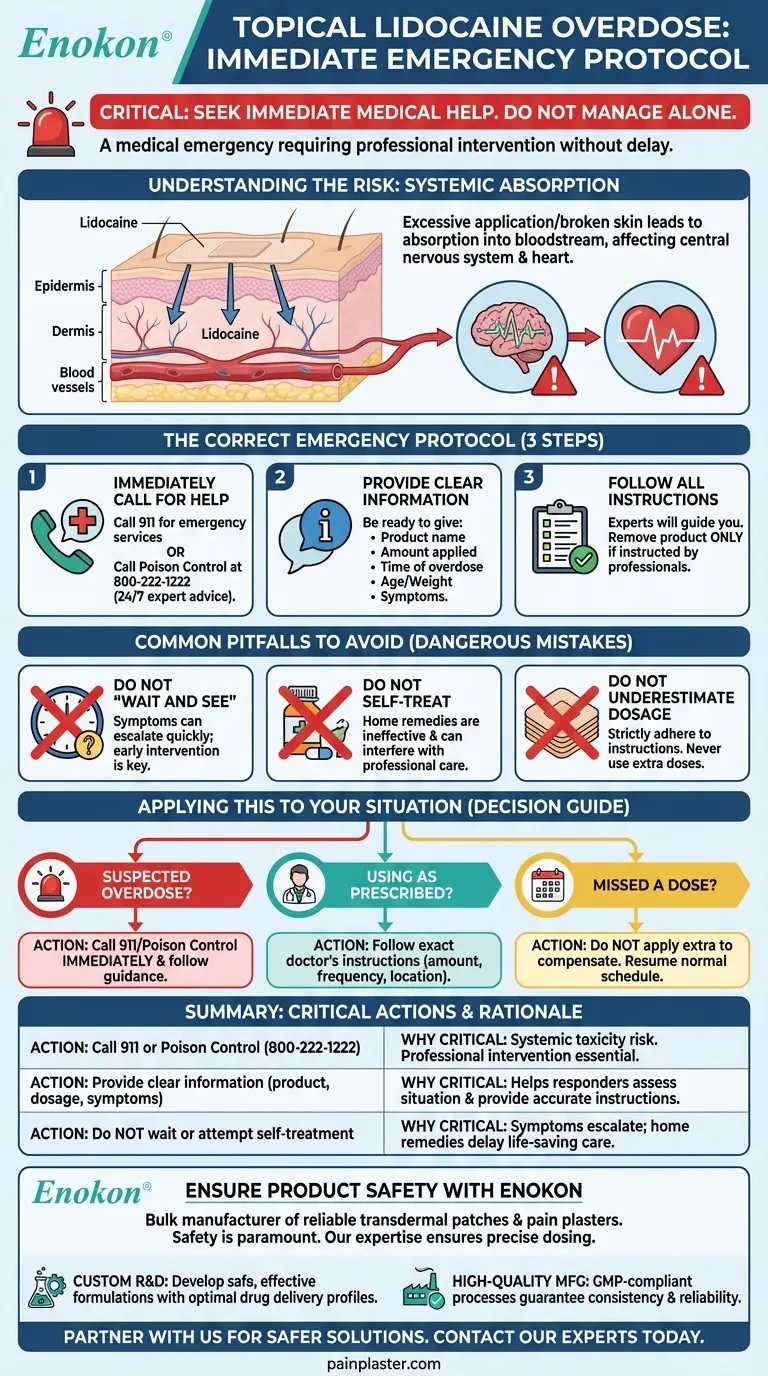In the event of a topical lidocaine overdose, you must seek immediate medical help. This is a serious medical situation that requires professional intervention without delay. The most critical first step is to call 911 or the Poison Control hotline.
A topical lidocaine overdose is a medical emergency because the medication can be absorbed into the bloodstream and affect the central nervous system and heart. Do not attempt to manage the situation on your own; your immediate priority is to contact emergency medical professionals.

Understanding the Urgency
Topical medications can seem harmless, but lidocaine is a powerful anesthetic. When applied excessively, to broken skin, or over a large surface area, it can be absorbed systemically, leading to toxicity.
The Risk of Systemic Absorption
Lidocaine works by blocking nerve signals in the skin. When too much enters your bloodstream, it can begin to block critical nerve and cardiac signals throughout your body. This is known as systemic toxicity and is the primary danger of an overdose.
Why Professional Help is Non-Negotiable
The effects of a lidocaine overdose can escalate quickly and require specific medical treatments that can only be administered in a clinical setting. Paramedics and emergency room staff are trained to manage these specific toxic effects.
The Correct Emergency Protocol
In a high-stress situation, having a clear action plan is crucial. Follow these steps precisely if you suspect an overdose for yourself or someone else.
Step 1: Immediately Call for Help
Your first and most important action is to call for professional medical assistance.
- Call 911 for immediate emergency services.
- Call Poison Control at 800-222-1222. They provide expert advice 24/7.
Step 2: Provide Clear Information
Be prepared to give the operator as much information as possible.
- The name of the product used.
- The amount of lidocaine applied.
- The time the overdose occurred.
- The age and weight of the person affected.
- Any symptoms the person is experiencing.
Step 3: Follow All Instructions
Emergency operators or Poison Control experts will give you specific instructions. This may include removing any remaining product or patch from the skin to prevent further absorption, but only do so if instructed.
Common Pitfalls to Avoid
What you don't do in an emergency is as important as what you do. Avoid these common and dangerous mistakes.
Do Not "Wait and See"
Never assume the symptoms are minor or will resolve on their own. The onset of severe effects can be delayed, and early intervention is critical for a positive outcome.
Do Not Try to Self-Treat
Do not attempt to administer any home remedies, food, or liquids to counteract the overdose. Such actions are ineffective and can interfere with professional medical treatment.
Do Not Underestimate the Dosage
Always adhere strictly to the dosage instructions provided by your healthcare provider or listed on the product packaging. Never use extra doses to make up for a missed application.
Applying This to Your Situation
Your response should be dictated by the situation. Use these guidelines to make the right decision.
- If you suspect an overdose may have occurred: Your only action is to call 911 or Poison Control immediately and follow their guidance.
- If you are using topical lidocaine as prescribed: Ensure you are following the exact instructions from your doctor, including the amount, frequency, and location of application.
- If you have missed a dose: Do not apply extra lidocaine to compensate; simply resume your normal schedule or consult your healthcare provider.
Ultimately, understanding and respecting the power of this medication is the key to using it safely.
Summary Table:
| Action | Why It's Critical |
|---|---|
| Call 911 or Poison Control (800-222-1222) | Lidocaine overdose can cause systemic toxicity, affecting the heart and nervous system. Professional medical intervention is essential. |
| Provide clear information (product, dosage, symptoms) | Helps emergency responders assess the situation and provide accurate instructions. |
| Do NOT wait or attempt self-treatment | Symptoms can escalate quickly. Home remedies are ineffective and can delay life-saving care. |
Ensure the Safety of Your Topical Pain Relief Products
At Enokon, we are a bulk manufacturer of reliable transdermal patches and pain plasters for healthcare and pharmaceutical distributors and brands. We understand that product safety is paramount. Our technical expertise ensures precise dosing and controlled delivery in every patch we produce.
Partner with us for:
- Custom R&D and Development: We can help you develop safe, effective topical formulations with optimal drug delivery profiles to minimize risks.
- High-Quality Manufacturing: Benefit from our GMP-compliant processes that guarantee consistency and reliability in every batch.
Let's work together to create safer pain management solutions for your customers.
Contact our experts today to discuss your product needs.
Visual Guide

Related Products
- Far Infrared Heat Pain Relief Patches Transdermal Patches
- Lidocaine Hydrogel Pain Relief Patch for Pain Relief
- Far Infrared Knee Pain Patch Heat Patches for Pain Relief
- Far Infrared Pain Patch Relief Pain Reliever for Back
- Asthma Cough and Pain Relief Patch for Adults and Kids
People Also Ask
- What types of pain can the Deep Heat Pain Relief Back Patch be used for? Targeted Relief for Muscles & Joints
- How does the Deep Heat Back Patch work? A Drug-Free Solution for Targeted Pain Relief
- How does capsaicin work in the medicated heat patch? The Science Behind Pain Relief
- How quickly does the Deep Heat Pain Relief Back Patch activate and how long does it provide warmth? Get 16-Hour Relief
- What did the UK Million Women Study find regarding transdermal versus oral hormone therapy? A Safer Choice for Gallbladder Health










